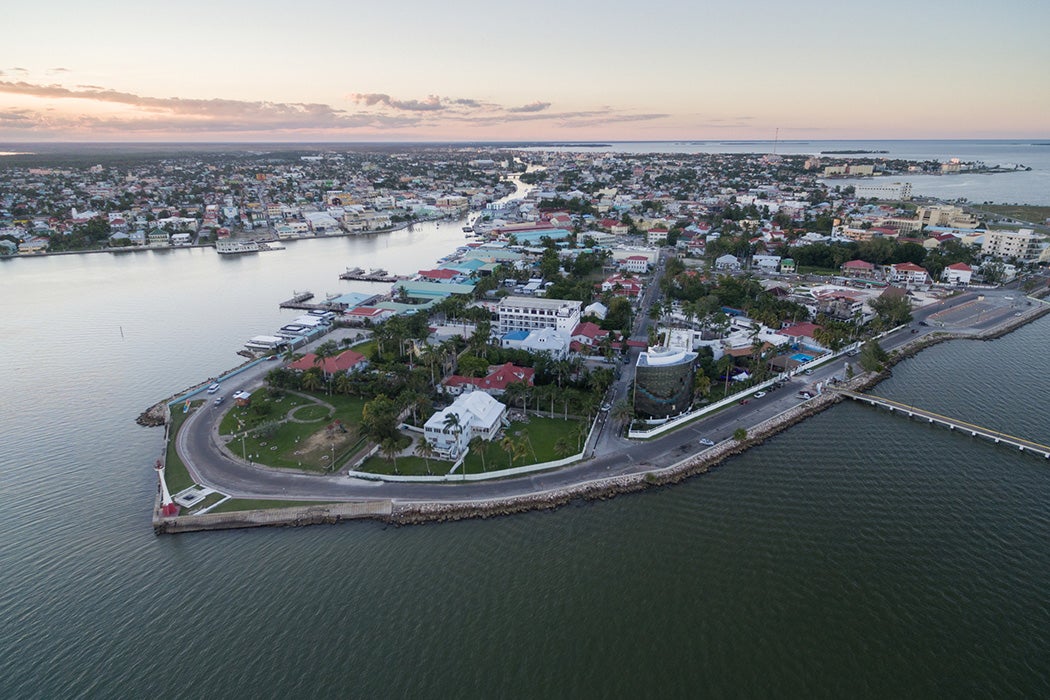As far as priorities went when it came to sorting through the inbox on her desk in 1981, British Prime Minister Margaret Thatcher, it’s safe to assume, was thinking more about the urban riots plaguing the nation than the tribulations of a country with a population of less than half a million on the other side of the Atlantic Ocean. But September 21 of that year marked a seismic moment in the history of British colonialism, for it was on that day that the UK’s last territory in the Americas declared independence.
Belize had already changed its name from British Honduras almost a decade earlier, rendering obsolete this most patrician of colonial possession names. The region had long been a source of fascination to archaeologists and historians back in London, as demonstrated by a 1927 report from the British Museum Journal, in which Thomas Athol Joyce describes (with accompanying photographs) an expedition to the Mayan ruins of Lubantun. Joyce catalogues the “discovery” of pyramids, charm stones, and figurines that dated back to 730 CE.
By the time the British Museum was exploring the plains, jungles, and mountains of Belize, the colonial system’s nefarious impact on both people and nature had long taken hold. In a 2003 essay, Melissa A. Johnson writes that the nineteenth century was a time “when racial discourse sedimented and the Belizean economy was dominated by mahogany extraction.” Johnson’s work explores the formation of Belizean “Creole” identity during this inimical era, detailing reports that described the dehumanizing nature of the back-breaking work enslaved workers undertook in chopping mahogany.
The years following independence brought radical change to Belize. As Anne Sutherland argues in her 1996 essay, the nation skipped a “modernist” era completely, transforming from an obscure backwater into a post-modernist hub for tourists in search of “authenticity.” Many first-time visitors were motivated by the intrigue suggested in a novel written by Aldous Huxley following a visit there decades earlier. According to Huxley, “if the world had any end, British Honduras would certainly be one of them. It is not on the way from anywhere to anywhere else. It has no strategic value. It is all but uninhabited.”
It is, Sutherland argues, quotes like this that provided a springboard for a modern Belizean identity that would attract visitors. She writes that,
the move from being nowhere to somewhere is related to the history of different people who have migrated, fled, or escaped to Belize, forming the culture as we know it today. Into this “ethnoscape” of migrant groups, a small population and a rudimentary local economy of sugar, fish, and wood, enter tourists, many kinds of tourists and many adventuresome individuals who have reshaped Belize…
This re-shaping has been ongoing since the rapid decline of wood as the most important component of the national economy. One of the most seismic changes occurred in the 1960s, when Belize became one of the very few nations to move its capital city, a relocation prompted when Hurricane Hattie devastated Belize City.
The move to today’s capital, Belmopan, became official in 1970, though, as John C. Everitt argues in his 1986 analysis of the growth and development of Belize City, quoting Narda Dobson’s History of Belize, “it is now generally agreed that it ‘is unlikely that Belize City will (ever) lose its importance as a trading and mercantile centre of the country.’ The advantages of location and inertia are simply too great to be overcome by the paucity of resources available to Belize.”
Everitt may have been writing nearly forty years ago, but his prediction was correct. Belmopan, with its population of barely 16,000, is the smallest capital city in the Americas while Belize City maintains a population of more than 60,000, making it a symbolic capital at the very least.
Weekly Newsletter
However, for visitors, a trip to modern day Belize is unlikely to have much of a focus on the nation’s urban settlements. Those Mayan ruins, one of the longest barrier reefs in the world, and myriad, precious wildlife are the main draws to the ever-increasing visitor numbers. Yet, Belize’s allure as a place to see nature at its most untrammeled also contains narratives, collisions, and contradictions that encapsulate this nation’s meteoric rise from obscurity. Michael K. Steinberg argues in a 2016 article on jaguar conservation in the southern part of the country, that through its creation of sanctuaries and national parks,
Belize has been rightfully lauded as a leader in nature-based tourism and protected areas creation in Central America. However, outside national parks and communities that directly benefit from ecotourism, it is less clear how supportive rural residents are of cat conservation.
Steinberg discovers, through interviews with villagers, that love for these big cats is far from ubiquitous, with many claiming that either their domestic pet dogs or hunting dogs have been killed by jaguar attacks, causing intense emotional distress.
Belize is far from the only post-colonial nation in the Caribbean and Central Americas region dealing with a shift from anonymity to one of being, for outsiders from wealthier nations at least, a supposed paragon of authenticity and conservation. Yet few have undergone this transition as rapidly as the former British Honduras. It would seem Aldous Huxley was wrong: Belize is most definitely on the way to somewhere; but the direction of travel, both culturally and environmentally, is yet to be fully established.







